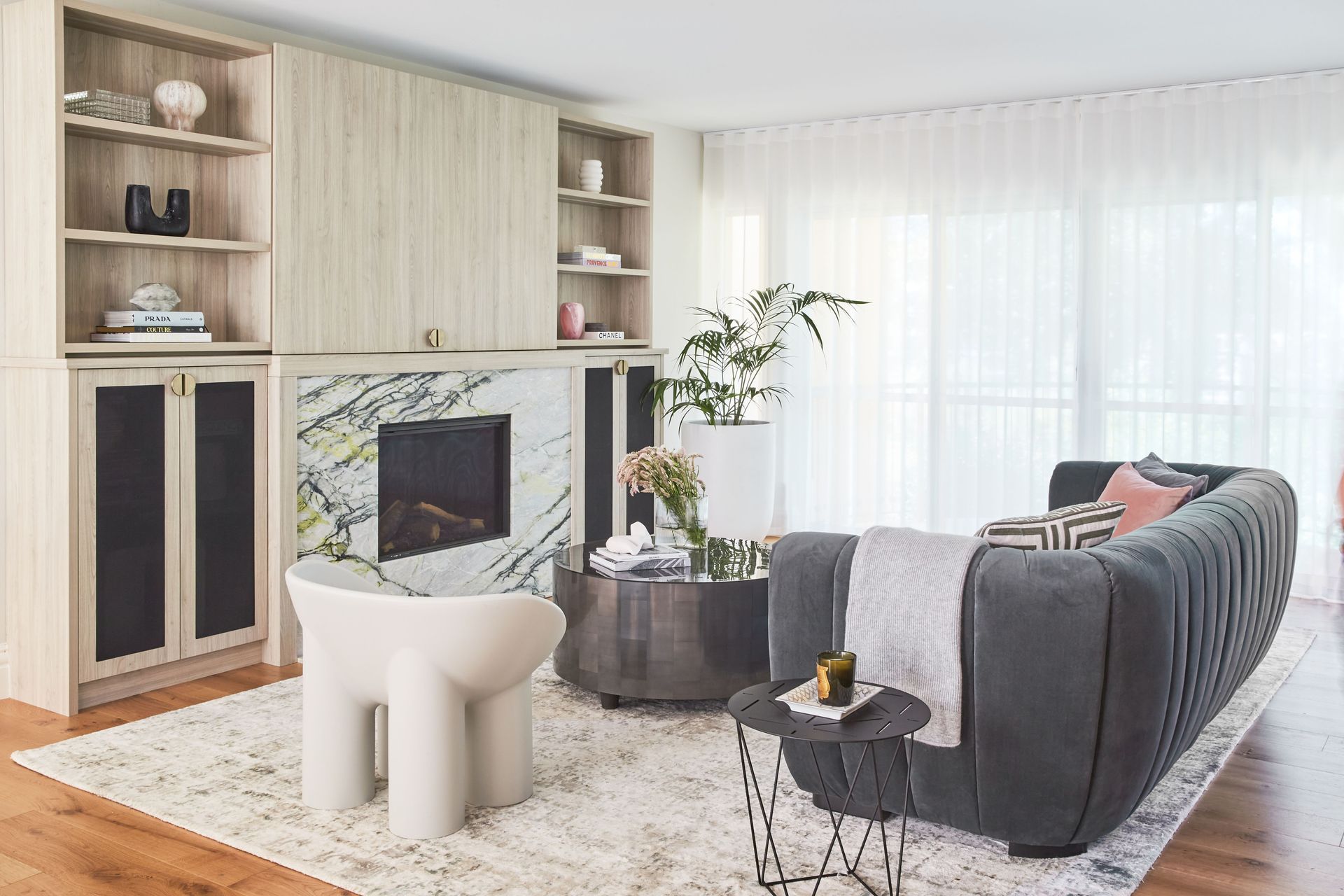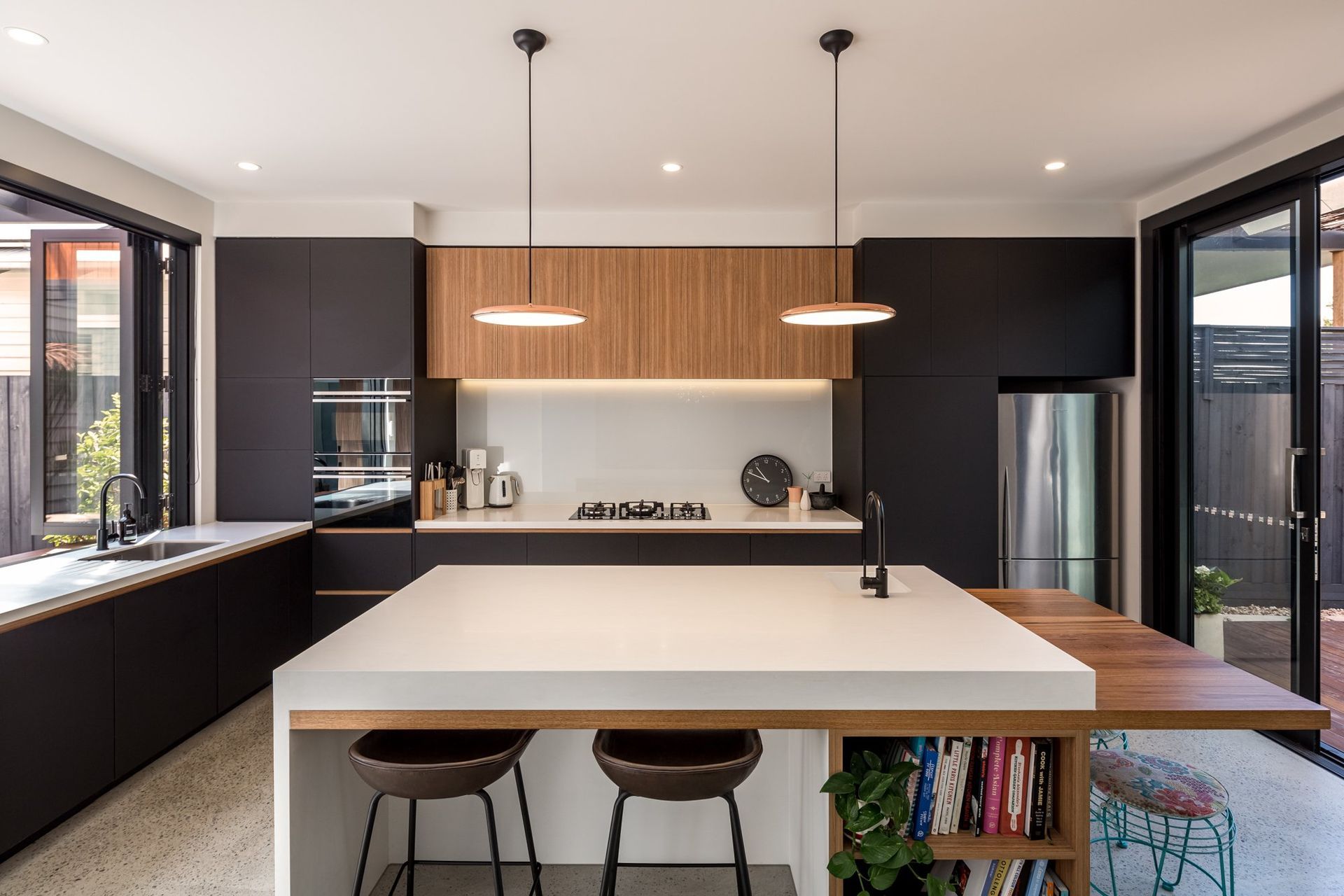An essential guide to furnishing and organising a new home in Australia

With so many decisions to make, the process of furnishing a new home can quickly become overwhelming. Fortunately, with some organisation and strategic planning, you can simplify the process and avoid unnecessary stress. Breaking down the needs for each living space room by room is a great way to get started, ensuring nothing is forgotten.
1. Living room
When designing your living room, focus on comfort and creating a space with good flow. Choose a sofa that suits your needs, and add functional furniture like coffee and side tables, ensuring there's enough space for easy movement. Incorporate cosy elements such as rugs, cushions, and throws to soften the room and create warmth. Consider layered lighting, using floor lamps, table lamps, and overhead fixtures to achieve a relaxed yet well-lit environment.
Essential items
- Couch
- Coffee table and side tables
- Entertainment centre or TV stand
- TV or projector system
- Lamps (floor or table) and overhead lighting fixtures
- Curtains, blinds, or window treatments
- Bedside tables
Optional upgrades
- Sound system or speakers
- Area rugs
- Throw pillows, blankets
- Wall art, mirrors, or other decorative pieces
- Storage for games, movies, books, etc.
- Firewood holder (if you have a fireplace)
- Houseplants or greenery

2. Dining room
In your dining room, prioritise a dining table and chairs that fit the space and accommodate guests if you like entertaining. A sideboard can provide valuable storage for tableware and linens, while table décor or a stylish centrepiece can enhance the atmosphere. Opt for practical table linens that are easy to clean, and if you entertain often, a bar cart or drinks station can be a helpful addition.
Essential items
- Dining table and chairs
- Over table lighting
- Dinnerware
- Glassware
- Curtains/blinds (if you have windows)
Optional upgrades
- Sideboard or buffet for extra storage
- Table linens
- Centrepiece or table décor
- Bar cart or beverage station
- Wall art, mirrors, or other decorative pieces
- Rug
- Candles/ candle holders
- Cushions

3. Kitchen
In the kitchen, focus on functionality by investing in essential appliances like a fridge, cooker, and dishwasher that suit your lifestyle. To make cooking more efficient, organise your cabinets and pantry with shelves and storage jars. Small appliances such as a toaster or blender should be easily accessible, and ample worktop space is key for meal preparation. For convenience and sustainability, you might also consider a water filter or dedicated recycling bins.
Essential items
- Refrigerator and freezer (or separate chest freezer)
- Stove or oven
- Large pots, pans, and baking trays
- Plates, bowls, cutlery, serving dishes
- Glasses (water, wine, mugs, etc.)
- Rubbish and recycling bins
- Dishwasher soap and sponges
- Kitchen towels, pot holders, oven mitts
- Microwave, toaster, coffee maker, blender (depending on preference and usage)
- Small kitchen gadgets (can opener, garlic press, etc.)
- Dishwasher
Optional upgrades
- Pantry organisation (shelves, jars, bins)
- Kitchen island or extra counter space (if not built-in)
- Water filter (if necessary)
- Warming drawers
- Bar or wine fridge

4. Bedrooms
Comfort is key in the bedroom, so invest in a good bed, mattress and high-quality bedding. Use wardrobes, drawers, and bedside tables to keep your space organised, and ensure bedside lamps provide adequate lighting. Maximise storage with closet organisers or under-bed boxes, and use curtains or blinds to maintain privacy and control light. A full-length mirror can be both functional and space-saving.
Essential items
- Beds or bed frames with mattresses
- Dressers, wardrobes, or closets with organisation
- Nightstands and lamps
- Bedding (mattress covers, sheets, pillows, comforters, blankets)
- Curtains or blinds for privacy
Optional upgrades
- Bedroom rugs or carpets
- Full-length mirrors
- Smart home system

5. Bathrooms
Keep your bathroom practical and tidy with ample storage for towels, toiletries, and cleaning supplies. Stock up on soft bathmats and towels to add comfort, and make sure everyday items like soap and toilet rolls are within easy reach. A well-illuminated mirror can improve your morning routine, and shelves or cupboards can make the most of limited space. Don't forget a laundry basket to keep the space clutter-free.
Essential items
- Shower and enclosure/curtain
- Toilet
- Bathtub
- Bathmats, towels, and washcloths
- Toilet paper holders, soap dispensers, toothbrush holders
- Bathroom storage (cabinets, shelving, or bins)
- Bathroom vanity
- Bathroom ventilation/extractor fans
- Vanity mirror with lighting
- Laundry hamper for towels/clothes
- Toilet brush, plunger, and cleaning supplies
- Towels (bath and hand)
- Bathroom heater
Optional upgrades
- Heated towel rack
- Towel rack
- Bidet
- Heated floors

6. Home office or study (if applicable)
Create a productive workspace with a sturdy desk and ergonomic chair for comfort during long working hours. Keep your office organised with shelves or filing cabinets for documents and supplies. Proper lighting is essential, so use natural and task lamps to reduce eye strain. If possible, set up a dedicated internet router to ensure your connection is reliable, and keep the space free of distractions for maximum focus.
Essential items
- Desk and ergonomic chair
- Computer or laptop with monitor setup
- Printer and office supplies (pens, paper, stapler, etc.)
- A filing cabinet or document storage
- Bookshelves or storage for office items
- Lighting (desk lamp, overhead light)
- Surge protectors
Optional upgrades
- Standing desk
- Multiple monitors
- Smart speaker or virtual assistant
- Mini fridge

7. Laundry room
A well-organised laundry room can make washing easier. Choose a washing machine and dryer that fit your household’s needs, and organise your laundry products like detergents and fabric softeners in easy-to-reach places. A folding station or countertop will make laundry tasks more manageable, and having a drying rack or ironing board within reach is essential. Use separate laundry baskets to streamline the process.
Essential items
- Washer and dryer
- Laundry baskets and hampers
- Ironing board and iron
- Drying racks
- Folding station or counter space
- Laundry cabinets
- Laundry tub and faucet
Optional upgrades
- Steamer
- Ironing board station

8. Outdoor spaces (yard, garden, patio)
Make your outdoor space both comfortable and functional with weatherproof furniture that suits your garden or patio. If you enjoy outdoor cooking, a barbecue or outdoor kitchen area can enhance gatherings, while gardening enthusiasts should invest in tools and planters. Lighting, such as fairy lights or solar lamps, can make the space usable in the evening, and consider a fire pit or outdoor heater for cooler nights.
Essential items
- Deck or patio
- Patio furniture
- Outdoor shelter or shades
- Garden tools (rake, shovel, lawnmower, etc.)
- Garden shed
- Outdoor lighting
Optional upgrades
- BBQ grill or outdoor kitchen setup
- Planters or raised garden beds
- Lawn décor

9. Garage or storage room
Maximise garage storage by installing shelves or cabinets for tools, car supplies, and seasonal items. A well-organised toolkit will save time on projects and repairs, and proper storage for bicycles and outdoor equipment will prevent clutter. Ensure you have large bins for recycling and garden waste, and keep extension leads and power strips easily accessible for practical use.
Essential items
- Garage storage and shelving or cabinets for tools and seasonal items
- Garage lighting
- Tool kit (hammer, screwdriver, wrench, etc.)
- Ladder, step stool
- Large rubbish can for yard waste or recycling
Optional upgrades
- Bicycles and bicycle storage

10. Entryway/hallways
Keep your entryway clutter-free with a shoe rack, bench, and hooks for coats and bags. An entry table is handy for holding keys, posts, and small items, while a mirror near the door is great for final checks before leaving the house. A durable welcome mat will help prevent dirt from being tracked inside, keeping your home cleaner.
Essential items
- Coat hooks, racks, or closets
- Key hooks/storage
- Entryway lighting
- A shoe rack or entryway bench
Optional upgrades
- Mirror for final outfit checks
- Welcome mat, area rugs or hallway runners
- Entryway table for mail, keys, etc.
- Wall art
11. Safety and utilities
Make safety a priority by installing smoke and carbon monoxide detectors throughout your home. Keep a fire extinguisher and emergency kit in an accessible location, and consider a home security system for added peace of mind. Stock up on spare light bulbs, batteries, and extension leads, and ensure your heating and cooling systems are regularly serviced to maintain a comfortable living environment.
Essential items
- Smoke detectors and carbon monoxide detectors
- Fire extinguisher
- Lightbulbs, batteries, extension cords
- Flashlights, candles, emergency kit
- Heating and cooling system (space heaters, fans, AC units)
Optional upgrades
- Security system (cameras, smart locks, etc.)

12. Miscellaneous
To keep your home clean and well-organised, have a range of cleaning supplies, such as a vacuum, mop, and cleaning products, ready. Smart home devices can offer convenience, whether through automated lights or smart thermostats. Store seasonal items and extra furniture in an organized manner to free up space, and check regularly that light fixtures, fans, and window screens are in good condition.
Essential items
- Cleaning appliances and products (vacuum, mop, broom, cleaning agents)
- Light fixtures or ceiling fans
Optional upgrades
- Storage for seasonal decorations
- Extra furniture for guests
- Smart home devices (thermostat, speakers, cameras)

Enjoy furnishing your new home
Furnishing and setting up a new home in Australia is an exciting journey, but it requires careful planning and consideration to ensure nothing is overlooked. From room essentials to legal documents, security measures, and the safety of children and pets, having a well-thought-out checklist can make the transition smoother and more enjoyable. By taking the time to budget wisely, measure your furniture, and prioritise key items based on your specific needs, you’ll create a home that is functional and personalised to suit your lifestyle. With the right planning and preparation, your new home will become a comfortable, secure, and welcoming space for years.
Related article: Why build a home in Australia? The benefits, challenges and solutions
